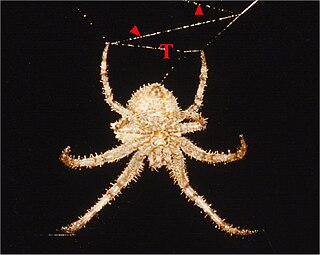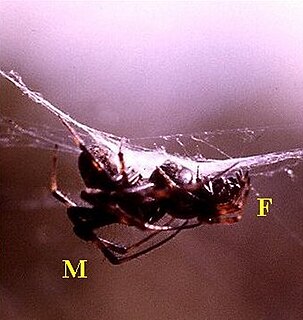
The marsh wren is a small North American songbird of the wren family. It is sometimes called the long-billed marsh wren to distinguish it from the sedge wren, also known as the short-billed marsh wren.

Kaira, sometimes called frilled orbweavers, is a mostly neotropical genus of orb-weaver spiders first described by O. Pickard-Cambridge in 1889. It includes sixteen described species that occur from South America up to the southern and eastern USA. It is presumably related to Aculepeira, Amazonepeira and Metepeira.

Metepeira labyrinthea, the labyrinth orbweaver, is an American dollar coin-sized spider, with thin legs and a round, bulbous abdomen It is a member of the genus Metepeira in the family Araneidae. The female’s length is 5.3 mm, its carapace 2.3 mm, abdomen 3.3 mm, and extended legs 18.4 mm. The carapace is brown or gray, and the abdomen is dark with a white pattern. The legs alternate pale brown and dark brown, and the sternum is dark brown with a longitudinal yellow mark. The male spider is three-quarters of the female’s length, or slightly larger, with a darker carapace and with greater contrast between dark and light areas of the legs. Metepeira are easily distinguished from other Araneidae by their light eye region, white median line on the sternum, relative length of the leg segments, small male palpus, weakly sclerotized epigyne and the special composite web.

Metepeira is a genus of orb-weaver spiders first described by F. O. Pickard-Cambridge in 1903. The name is derived from the Ancient Greek μετά and the obsolete genus name Epeira, denoting a genus similar to Epeira.

Isotomurus palustris, the marsh springtail, is a species of elongate-bodied springtail in the family Isotomidae. It is found in Europe, Africa, North America, and Central America.
Metepeira ventura is a species of orb weaver in the spider family Araneidae. It is found in the United States and Mexico.
Metepeira spinipes is a species of orb weaver in the spider family Araneidae. It is found in the United States and Mexico.
Metepeira arizonica is a species of orb weaver in the spider family Araneidae. It is found in the United States and Mexico.
Listronotus palustris is a species of underwater weevil in the beetle family Curculionidae. It is found in North America.
Metepeira crassipes is a species of orb weaver in the spider family Araneidae. It is found in the United States and Mexico.
Metepeira foxi is a species of orb weaver in the spider family Araneidae. It is found in the United States and Canada.
Metepeira gosoga is a species of orb weaver in the spider family Araneidae. It is found in the United States and Mexico.
Metepeira grandiosa is a species of orb weaver in the spider family Araneidae. It is found in North America.
Panorpa palustris is a species of common scorpionfly in the family Panorpidae. It is found in North America.
Metepeira pimungan is a species of orb weaver in the spider family Araneidae. It is found in the United States.
Metepeira comanche is a species of orb weaver in the spider family Araneidae. It is found in the United States and Mexico.

Lepyrus palustris is a species of true weevil in the beetle family Curculionidae. It is found in North America and Europe.
Metepeira minima is a species of orb weaver in the spider family Araneidae. It is found in a range from the United States to Honduras.
Metepeira datona is a species of orb weaver in the spider family Araneidae. It is found in the United States and Greater Antilles.

Metepeira incrassata, also known as the colonial orb-weaving spider, belongs to the spider family Araneidae and genus Metepeira. They are most famous for their social organization and group living behavior. They are generally found in tropical rainforest and agricultural sites in Mexico, and their habitats tend to be highly productive. Their group sizes are relatively larger than other colonial spiders, typically ranging from hundreds to thousands of individuals. 99% of the females are observed to participate in colonial living, generally with at least two other individuals. Because most M. incrassata females are communal, the colonies are often dominated by larger males. There is minimal sexual dimorphism observed in M. incrassata. Unlike other orb-weaver spiders, M. incrassata builds a colonial web by connecting each spider's individual webs together through semi-permanent framelines. These colonial webs of M. incrassata are prone to invasion by kleptoparasitic and araneophagic spiders such as the Theridiidae family. The reproductive cycle of M. incrassata occurs throughout the entire year, with multiple generations sharing the same time period. Within their colonies, M. incrassata is seen to change locations. Larger, fertile females with egg sacs prefer to reside in the central area of the group for increased protection from predators, while the younger spiders are mostly found in peripheral positions. Larger adult M. incrassata are also known to finish web-building earlier than smaller ones, gaining an advantage in strategically positioning themselves.






